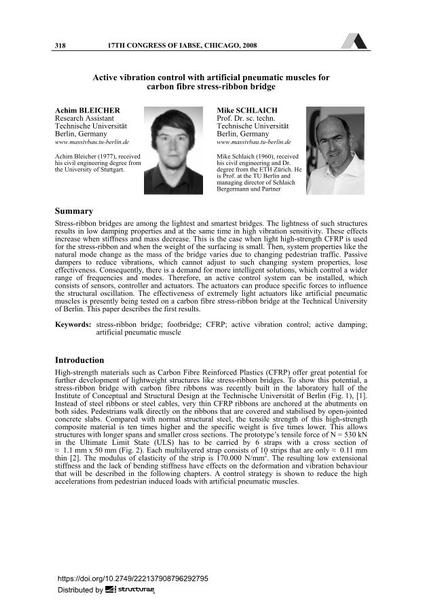Active vibration control with artificial pneumatic muscles for carbon fibre stress-ribbon bridge

|
|
|||||||||||
Détails bibliographiques
| Auteur(s): |
Achim Bleicher
Mike Schlaich |
||||
|---|---|---|---|---|---|
| Médium: | papier de conférence | ||||
| Langue(s): | anglais | ||||
| Conférence: | 17th IABSE Congress: Creating and Renewing Urban Structures – Tall Buildings, Bridges and Infrastructure, Chicago, USA, 17-19 September 2008 | ||||
| Publié dans: | IABSE Congress Chicago 2008 | ||||
|
|||||
| Page(s): | 318-319 | ||||
| Nombre total de pages (du PDF): | 8 | ||||
| Année: | 2008 | ||||
| DOI: | 10.2749/222137908796292795 | ||||
| Abstrait: |
Stress-ribbon bridges are among the lightest and smartest bridges. The lightness of such structures results in low damping properties and at the same time in high vibration sensitivity. These effects increase when stiffness and mass decrease. This is the case when light high-strength CFRP is used for the stress-ribbon and when the weight of the surfacing is small. Then, system properties like the natural mode change as the mass of the bridge varies due to changing pedestrian traffic. Passive dampers to reduce vibrations, which cannot adjust to such changing system properties, lose effectiveness. Consequently, there is a demand for more intelligent solutions, which control a wider range of frequencies and modes. Therefore, an active control system can be installed, which consists of sensors, controller and actuators. The actuators can produce specific forces to influence the structural oscillation. The effectiveness of extremely light actuators like artificial pneumatic muscles is presently being tested on a carbon fibre stress-ribbon bridge at the Technical University of Berlin. This paper describes the first results. |
||||
| Mots-clé: |
passerelle
|
||||
